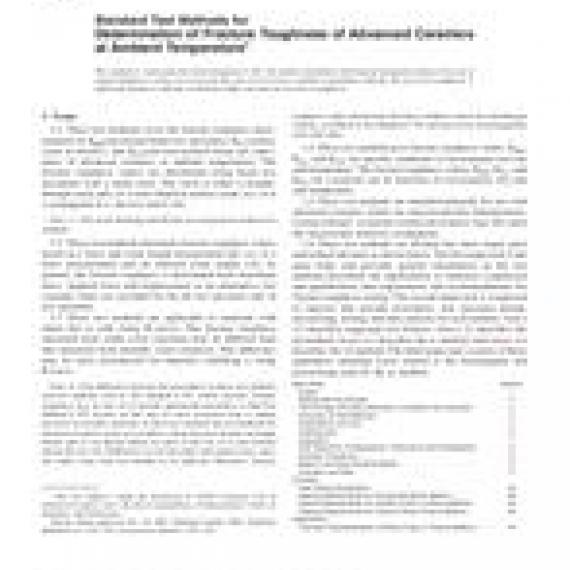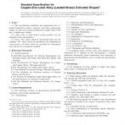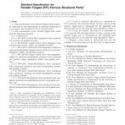No products
ASTM C1421-01b
ASTM C1421-01b Standard Test Methods for Determination of Fracture Toughness of Advanced Ceramics at Ambient Temperature
standard by ASTM International, 10/10/2001
Full Description
1.1 These test methods cover the fracture toughness determination of KIpb (precracked beam specimen), KIsc (surface crack in flexure), and KIvb (chevron-notched beam specimen) of advanced ceramics at ambient temperature. The fracture toughness values are determined using beam test specimens with a sharp crack. The crack is either a straight-through crack (pb), or a semi-elliptical surface crack (sc), or it is propagated in a chevron notch (vb).
Note 1 - The terms bend(ing) and flexure are synonymous in these test methods.
1.2 These test methods determine fracture toughness values based on a force and crack length measurement (pb,sc), or a force measurement and an inferred crack length (vb). In general, the fracture toughness is determined from maximum force. Applied force and displacement or an alternative (for example, time) are recorded for the pb specimen and vb specimen.
1.3 These test methods are applicable to materials with either flat or with rising R-curves. The fracture toughness measured from stable crack extension may be different than that measured from unstable crack extension. This difference may be more pronounced for materials exhibiting a rising R-curve.
Note 2 - One difference between the procedures in these test methods and test methods such as Test Method E 399, which measure fracture toughness, KIc, by one set of specific operational procedures, is that Test Method E 399 focuses on the start of the crack extension from a fatigue precrack for metallic materials. In these test methods the test methods for advanced ceramics make use of either a sharp precrack formed via bridge loading (pb) or via Knoop indent (sc) prior to the test, or a crack formed during the test (vb). Differences in test procedure and analysis may cause the values from each test method to be different. Therefore, fracture toughness values determined with these methods cannot be interchanged with KIc as defined in Test Method E 399 and may not be interchangeable with each other.
1.4 These test methods give fracture toughness values, KIpb, KIsc, KIvb, for specific conditions of environment, test rate and temperature. The fracture toughness values, KIpb, KIsc, and KIvb for a material can be functions of environment, test rate and temperature.
1.5 These test methods are intended primarily for use with advanced ceramics which are macroscopically homogeneous. Certain whisker- or particle-reinforced ceramics may also meet the macroscopic behavior assumptions.
1.6 These test methods are divided into three major parts and related sub parts as shown below. The first major part is the main body and provides general information on the test methods described, the applicability to materials comparison and qualification, and requirements and recommendations for fracture toughness testing. The second major part is composed of annexes that provide procedures, test specimen design, precracking, testing, and data analysis for each method. Annex A1 describes suggested test fixtures, Annex A2 describes the pb method, Annex A3 describes the sc method, and Annex A4 describes the vb method. The third major part consists of three appendices detailing issues related to the fractography and precracking used for the sc method.
| Main Body | Section |
| Scope | 1 |
| Referenced Documents | 2 |
| Terminology (including definitions, orientation and symbols) | 3 |
| Summary of Test Methods | 4 |
| Significance and Use | 5 |
| Interferences | 6 |
| Apparatus | 7 |
| Test Specimen Configurations, Dimensions and Preparations | 8 |
| General Procedures | 9 |
| Report (including reporting tables) | 10 |
| Precision and Bias | 11 |
| Annexes | |
| Test Fixture Geometries | A1 |
| Special Requirements for Precracked Beam Method | A2 |
| Special Requirements for Surface Crack in Flexure Method | A3 |
| Special Requirements for Chevron Notch Flexure Method | A4 |
| Appendices | |
| Precrack Characterization, Surface Crack in Flexure Method | X1 |
| Complications in Interpreting Surface Crack in Flexure Precracks | X2 |
| Alternative Precracking Procedure, Surface Crack in Flexure Method | X3 |
1.7 Values expressed in these test methods are in accordance with the International System of Units (SI) and Practice E 380.
1.8 This standard does not purport to address all of the safety concerns, if any, associated with its use. It is the responsibility of the user of this standard to establish appropriate safety and health practices and determine the applicability of regulatory limitations prior to use.


































